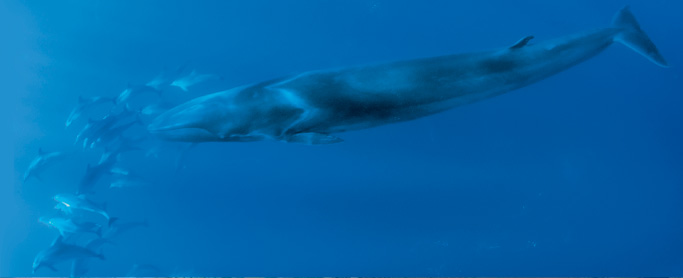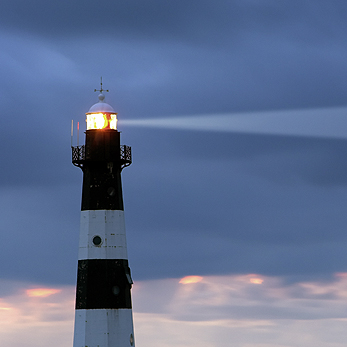Region V – Wider Atlantic

Region V is dominated by the High Seas, so effective management requires international cooperation. The only inhabitants are the 250 000 people living on the Azores.
Beyond the continental slope much of the seabed is an abyssal plain. Dissecting the abyssal plain is the longest mountain range in the world – the Mid-Atlantic Ridge – which runs from Iceland to the Azores and beyond. Both the continental slope and these underwater mountains support diverse biological communities, including cold-water coral reefs and deep-sea sponge communities. The Mid-Atlantic Ridge is an active tectonic boundary, with hydrothermal vents occuring along its length where hot mineral-rich seeps support forms of life that are only just starting to be understood.
Sharks, tuna and marlin roam the High Seas, migrating far beyond the boundaries of Region V.
To date, there is no exploitation of oil and gas in Region V, but deep-water fishing is exerting pressure on the ecosystems. There is a tendency for fishing to target accessible areas of the seabed, that is, isolated seamounts and shallower parts of the Mid-Atlantic Ridge – precisely where biodiversity is likely to be highest. Some of these areas are now protected. Deep-water fish species have been shown to be particularly sensitive to exploitation.
Region V is important for Europe’s threatened sea turtles, and wide-ranging oceanic seabirds like Cory’s shearwater.
The QSR 2000 concluded that the quality status of Region V was good but far from pristine. Issues of high importance were: over-fishing; large numbers of fish and marine mammals killed accidentally; lack of information about the impacts of climate change; mechanical damage to fragile habitats; expansion of the oil and gas industry into Region V; and increasing inputs of nutrients, hazardous substances, oil and litter.
| Eutrophication problem area extent | 0% |
| Species under threat | 21 |
| Habitats under threat | 7 |
| MPA coverage | 0.2% |
Successes
Some international cooperation to control fishing. The potential for illegal, unregulated and unreported fishing is causing concern in Region V. Countries are cooperating to control it by preventing individual blacklisted vessels from landing at their ports. This effort needs to be intensified. Gillnetting, discards and other impacts on fish, marine mammals and seabed habitats are being regulated by the North East Atlantic Fisheries Commission (NEAFC).
Protecting deep-sea habitats. Owing to the efforts of OSPAR, NEAFC, the EU and a number of OSPAR countries, some deep-sea habitats (including on the Rockall and Hatton Banks, a large area around the Azores, sections of the Mid-Atlantic Ridge and several seamounts) now have some protection and are closed to bottom fishing at the least on a temporary basis.
Ongoing concerns
Information is still limited. While many issues of concern remain the same as in 2000 for Region V, there is not enough new information to establish trends since 2000. In particular, OSPAR must promote the long-term observation and monitoring of the major habitats in Region V, such as continental margins, seamounts, the Mid-Atlantic Ridge, and abyssal plains. OSPAR should work on more detailed maps of the seafloor with information about the extent of different habitats, so it is clear where to focus surveillance effort.
Long-lived species slow to recover. The full extent of deep-water fishing effort is not known. Management measures were first introduced in 2004. Many deep-sea species are very long-lived, for example, the orange roughy can live for more than 100 years. Their populations are slow to recover when they have been depleted by over-fishing. Large whale species, whose populations fell due to heavy exploitation before the 1980s, are recovering very slowly.
Bluefin tuna in trouble. The status of the Eastern Atlantic and Mediterranean stock of bluefin tuna is of major concern. The population declined strongly over the past decade, but there are not enough data to assess with certainty how many bluefin tuna are left. In 2007, the annual catch of bluefin tuna was estimated to be double that allowed by the fishing authorities and well in excess of the level scientists believe to be sustainable. Improved surveillance seems to have reduced catches in 2008, but the need of further reductions in catches, better monitoring and regulation of the fishery is urgent.
Increasing industrial activity. Exploration for oil and gas is still continuing but production has not yet expanded into Region V. As the continental margins become depleted, mineral extraction, fishing and possibly fossil energy industries will turn their attention to the High Seas. Activities such as deep seabed mining could have significant impacts on the environment and marine life. OSPAR must gather as much information about this environment as possible, so that when such activities begin, it can support management that protects the most important and biodiverse sites.
MPAs in the High Seas. Establishing MPAs in the large area outside national jurisdiction in Region V is challenging. This is partly due to the difficulties of defining such areas, and the international cooperation required to manage them. Several candidate areas have been identified in Region V, but there are important jurisdictional issues to be addressed in considering their designation as MPAs. One candidate area is the Charlie Gibbs Fracture Zone, a complex section of the Mid-Atlantic Ridge. The proposed area would cover 5% of Region V, giving it the highest protected area coverage of any OSPAR Region.
What should be done?
- Continue and improve monitoring of fisheries
OSPAR must continue to collaborate with the North East Atlantic Fisheries Commission to monitor and assess fisheries in Region V.
Relevant fisheries organisations should be encouraged to expand the fisheries observer programme to gain better information on by-catch and accidental catches. - Focus on helping fish stocks recover
OSPAR must encourage the adoption of measures to aid the recovery of depleted fish stocks, including stocks that straddle several Regions, like the bluefin tuna. - Protect the Mid-Atlantic Ridge and isolated seamounts
OSPAR is working with other organisations to find the best way to establish an MPA that protects the unique ecosystems along the Mid-Atlantic Ridge and around isolated seamounts and seamount complexes. This would be a pioneering step towards protecting the marine life of the High Seas.

